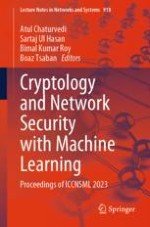2024 | OriginalPaper | Buchkapitel
NTPhish: A CNN-RNN Hybrid Deep Learning Model to Detect Phishing Websites
verfasst von : Chetanya Kunndra, Arjun Choudhary, Jaspreet Kaur, Aryan Jogia, Prashant Mathur, Varun Shukla
Erschienen in: Cryptology and Network Security with Machine Learning
Verlag: Springer Nature Singapore
Aktivieren Sie unsere intelligente Suche, um passende Fachinhalte oder Patente zu finden.
Wählen Sie Textabschnitte aus um mit Künstlicher Intelligenz passenden Patente zu finden. powered by
Markieren Sie Textabschnitte, um KI-gestützt weitere passende Inhalte zu finden. powered by
